

Historical trends in herbarium specimens could cause misleading observations. Extra care should be taken to avoid misinterpretation of data when looking at centuries-spanning specimens.
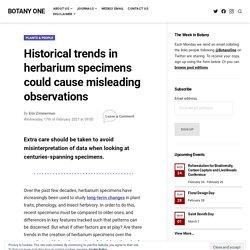
Over the past few decades, herbarium specimens have increasingly been used to study long-term changes in plant traits, phenology, and insect herbivory. In order to do this, recent specimens must be compared to older ones, and differences in key features tracked such that patterns can be discerned. But what if other factors are at play?
Collecting. Collections. Difficulties. Displays. Exhibits. Fossils. Paper. Personal. Seeds. Slides. Xylaria. Changes in plant collection practices from the 16 th to 21 st centuries: implications for the use of herbarium specimens in global change research. @SiobhanLeachman @IMBIV1 @museobotanico @GBIF @BloodhoundTrack @NHM_Botany Thanks @SiobhanLeachman.... So many solanums, so little time!! For me the herbarium is as important as the field.. Wierd twist to the work here is that I found isotypes of plants f.
Rationale. Despite the world-wide importance of natural history collections, most are at risk because they are critically underfunded or undervalued.
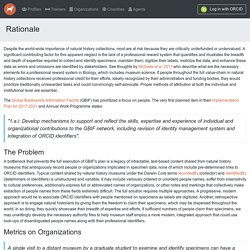
A significant contributing factor for this apparent neglect is the lack of a professional reward system that quantifies and illustrates the breadth and depth of expertise required to collect and identify specimens, maintain them, digitize their labels, mobilize the data, and enhance these data as errors and omissions are identified by stakeholders. See thoughts by McDade et al. 2011 who describe what are the necessary elements for a professional reward system in Biology, which includes museum science. If people throughout the full value-chain in natural history collections received professional credit for their efforts, ideally recognized by their administrators and funding bodies, they would prioritize traditionally unrewarded tasks and could convincingly self-advocate.
Bonnie Isaacs: Collected on this day - Mason Heberling. BCoN Communications Workshop Report. Survey Results: Harnessing Natural History Collections Data for Addressing National Challenges: The Biodiversity Collections and Data Wishlist. Biw060. Borderless Collections – Starting a Collections Community (R)evolution. The Museum’s Digital Collections Programme (DCP) was represented at a recent John Ellerman funded Strategy Workshop for UK collections at M Shed in Bristol.
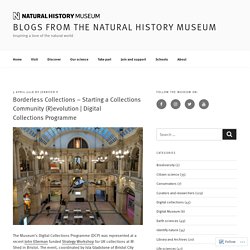
The event, coordinated by Isla Gladstone of Bristol City Council Culture Team, brought together a range professionals from across UK museums and related sectors including the UK biological recording community, policy specialists, the BBC Natural History unit and informaticians to discuss the development of a coordinated approach to digitising UK regional museum collections. As part of the workshop, Helen Hardy (DCP Programme Manager) presented an overview about measuring the impact of digitising collections and Vince Smith (Head of Informatics) spoke on new research opportunities created by bridging digital collections across institutions. The Workshop The workshop generated support across UK stakeholders for increasing cooperation and improving coordination in bringing national and regional digitisation activities together.
Kew’s Science Collections Strategy. Anchoring Biodiversity Information - Sherborn. Kew: Collection & Investigation of Plant Materials for Paper Making, c.1830-1914. A Paper World: The Collection & Investigation of Plant Materials for Paper Making, c.1830-1914 AHRC PhD Studentship Applications are invited for a fully-funded PhD studentship on the history of collections of plant materials for paper making at Royal Holloway, University of London, in partnership with the Royal Botanic Gardens, Kew.
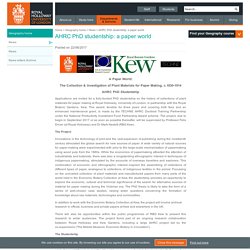
This award, tenable for three years and covering both fees and an enhanced maintenance grant, is made by the TECHNE AHRC Doctoral Training Partnership under the National Productivity Investment Fund Partnership Award scheme. The project, due to begin in September 2017 or as soon as possible thereafter, will be supervised by Professor Felix Driver (at Royal Holloway) and Dr Mark Nesbitt (RBG Kew).
The life cycle of an object. Wardian case arriving at Kew The life cycle of an object Beth Wilkey, Project Officer This wooden, glazed container is known as a Wardian case and was used in the 19th century to transport living seeds and plants all over the world.
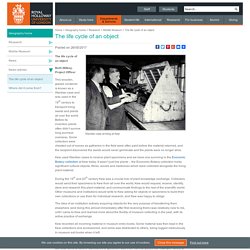
Before its invention plants often didn’t survive long journeys overseas. Gifted herbaria and volunteers. The RBGE Herbarium is frequently gifted plant specimens from individual collectors.

In recent years we have received material from T. Powell (seaweeds) F. Dobremez (flora of Nepal) C. Townsend (mosses) C.R. Rare flowers discovered in Roman hoard. George Clifford Herbarium and ornaments. Finding plants missing from collections. Plant Heritage is highlighting ten missing plant genera which currently are not represented within National Plant Collections®, as part of a campaign to be launched during RHS Hampton Court Palace Flower Show (5th to 10th July).
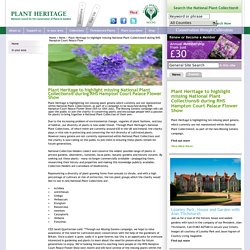
The Missing Genera campaign will call upon the public to join the charity in conserving plants and encourage people with a passion for plants to bring together a National Plant Collection of their own. Natural Science Collections Alliance » Publications. On the Importance of Scientific Collections This new series of special reports by NSC Alliance takes an in depth look at scientists and institutions who are using scientific collections.

NatSCA. Name: Paolo Viscardi Job Title & Institution: Curator of the Grant Museum of Zoology, UCL Twitter username: @PaoloViscardi Paolo Viscardi, in the Grant Museum’s amazing Micrarium What is your role on the NatSCA committee?
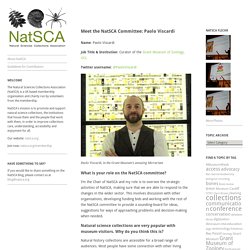
The challenges faced by living stock collections in the USA. Introduction The goals of living stock collections are to preserve the genetic diversity of target organisms, to maintain research materials, and make these resources available to researchers around the world.

Living stock collections are distinct from other bio-repositories, such as natural history museums (Rocha et al., 2014) and biobanks (Baker, 2012), because the resources they contain are generally capable of being multiplied and propagated. This creates unique challenges for long-term sustainability. The collections are typically housed within stock centers, seed banks, vivariums and botanical gardens, which are usually based at a university or other research institution. The germplasm collection: a library of apples. Storing genetic information from apples A germplasm is a library of genetic resources for an organism. Germplasm collections can be stored in several ways – as seeds in cool storage, as whole plants in a nursery or orchard or as cryopreserved dormant buds. At Plant & Food Research (PFR), the apple germplasm collection is maintained in the form of trees in the orchard. 2 trees of each genotype are planted.
It’s important to maintain an apple germplasm collection as trees because apples don’t breed true. Wild relatives of key crops not protected in gene banks, study finds. The wild, sometimes scraggly cousins of grains and vegetables have a role to play in food security, but urgent action is needed to conserve them, says a new study published today in Nature Plants. The first global survey of the distribution and conservation of 1076 wild relatives of 81 crops finds that more than 95% are insufficiently safeguarded in the world’s gene banks, which store seeds and other plant tissues that can be used for future breeding efforts.
Some 70% of the wild populations examined by the study, including the relatives of banana, cassava, wheat, and sorghum, are considered high priority for collection; 300 could not be located in any gene bank. Crop wild relatives are, in essence, evolutionary experiments. Without coddling from farmers, these hardy plants withstand drought, pests, and disease. As a result, they often evolve valuable traits that plant breeders could use to create varieties able to resist pests or maintain yields in the face of global warming. National Center for Genetic Resources Preservation : Home. A ‘Time Capsule’ for Scientists, Courtesy of Peter the Great. ST. PETERSBURG, Russia — Standing alone, a few minutes before the doors were to open at the Zoological Museum of the Zoological Institute of the Russian Academy of Sciences, Alexei Tikhonov gazed at Masha, a 30,000-year-old baby mammoth that he brought here from a Siberian riverbank thirty years ago.
Masha, one of the museum’s star attractions, rests with hundreds of other encased exhibits in one of the largest public collections of zoological specimens in the world. The cabinets, conceived in Frankfurt at the end of the 19th century, and the Czarist hunting trophies here exude an old-fashioned, even romantic air. But Dr.